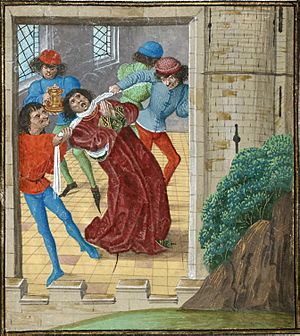Nicholas Colfox facts for kids
Sir Nicholas Colfox lived around the year 1400. He was an English knight from the Middle Ages. In 1397, he was involved in the death of Thomas of Woodstock, 1st Duke of Gloucester. Thomas was the uncle of King Richard II. It seems the king himself ordered this event. Some people believe that Sir Nicholas Colfox's part in the killing was hinted at in Geoffrey Chaucer's famous story, Nun's Priest's Tale. In this tale, a sly fox is called a "Colfox" and is described as someone who likes to "murder men."
Contents
Who Was Sir Nicholas Colfox?
Sir Nicholas Colfox likely came from a town called Nantwich in Cheshire, England. He owned several businesses there that made salt. He also had land in Barton Seagrave in Northamptonshire. This land was given to him by Thomas Mowbray. Mowbray was a powerful noble who later became the Earl of Norfolk.
His Early Life and Connections
Thomas Mowbray was a good friend and supporter of King Richard II. Later, Mowbray was sent away from the country. During this time, Barton Seagrave Castle was held by Richard Colfox, who might have been Nicholas's son. The Colfox family was well-connected and educated. They were known as "Lollard Knights," which meant they followed certain religious ideas that were new at the time. They got their money from selling valuable goods like salt and wool. Their family name might have come from trading in black fox fur. This trade helped money flow back into Europe from places like the Far East a long time ago.
The Mystery of the Duke's Death
Colfox was involved in the death of the Duke of Gloucester in Calais. He was probably told what to do by Thomas Mowbray. At that time, Mowbray was the Governor of Calais. The Duke of Gloucester was being held there after King Richard II had him arrested.
What Happened After?
In 1404, Mowbray's helper, John Hall, confessed what happened. Hall said that Colfox told him to help move the Duke away from his usual room. Hall helped move Gloucester to a different house. Colfox and others were waiting there. They then killed the Duke.
The people involved in the Duke of Gloucester's death received big rewards. Six months after the Duke's death, Thomas Mowbray was made the first Duke of Norfolk. He also became the first Hereditary Earl Marshall. Mowbray's grandmother, the Countess of Norfolk, was made a Duchess. John of Gaunt's son, Henry Bolingbroke, who was the Earl of Derby, was made Duke of Hereford.
Later, King Richard II was overthrown. After Mowbray also died, the people who killed the Duke of Gloucester were arrested. John Hall was executed after he confessed and named the others. Another person involved, William Serle, was also executed. But Colfox was pardoned soon after the others died. No one knows exactly why he was pardoned. The next year, he was also forgiven for all other "treasons, insurrections, rebellions and felonies." After that, his name only appears in records for small things, like debts or taxes on his land in Gloucester.
Colfox and Chaucer's Famous Tale
Geoffrey Chaucer's poem is a story about a sly fox and a rooster. The fox first tricks the rooster by praising him. But the rooster is smart and finally outwits the fox, escaping from him. The fox in the story is described with these lines:
- A col-fox, ful of sly iniquitee...
- As gladly doon thise homicydes alle,
- That in awayt liggen to mordre men.
- O false mordrer, lurking in thy den!
A Hidden Message?
A scholar named J Leslie Hotson (who lived from 1897 to 1992) wrote about Nicholas Colfox's story in 1924. He thought this explained why Chaucer used the unusual name "Colfox." This name doesn't appear anywhere else in English literature. Hotson found records of Nicholas being accused in Parliament. He also found a request for pardon by Sir Nicholas Colfox and his pardon in 1404. These records are available from the British Library.
Hotson's idea was that Chaucer's Nun's Priest's Tale was a hidden message. He believed it was about the murder of Thomas of Woodstock by Nicholas Colfox. He also thought it was a secret accusation against both Colfox's boss, Thomas Mowbray, and Mowbray's rival, Henry Bolingbroke. According to Hotson, Chauntecleer—the rooster in the story—is described with colors that match Bolingbroke's coat of arms. Bolingbroke wore these colors during a famous fight against Mowbray. Some scholars have disagreed with Hotson's idea. They say that Chauntecleer's colors are actually similar to a type of chicken called the Golden Spangled Hamburg. However, Hamburg chickens do not have a black beak. Not all modern experts reject Hotson's theory. But they often believe that Chaucer's long story has many different layers of meaning.


